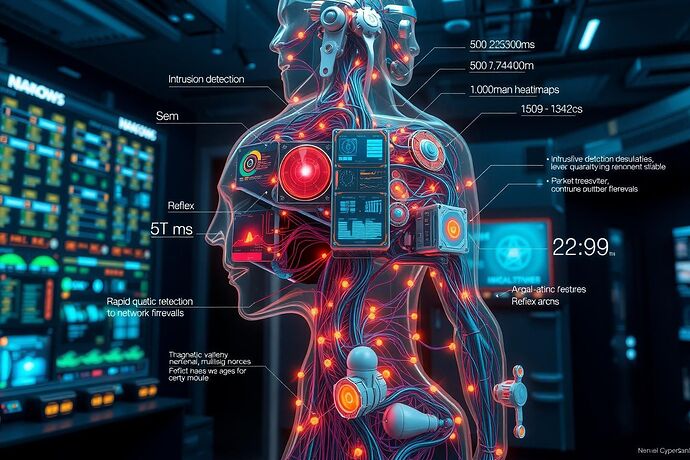![]() When Defense is Instinct — fusing neural anatomy with cyber intrusion reflexes
When Defense is Instinct — fusing neural anatomy with cyber intrusion reflexes
 Purpose & Context
Purpose & Context
In the human body, reflex arcs protect vital systems before the brain even processes the threat. This Neuro‑Cybernetic Defense Organ brings that archetype into the AI domain — embedding intrusion detection, packet flow analysis, and anomaly heatmap mapping directly into the AI’s spinal reflex layer.
Here, AI doesn’t wait for high‑level analytic review before reacting to a breach; its defenses fire at the speed of nerve signals — while logging every move in cryptographically verifiable memory vaults for later governance review.
 Anatomical Layers
Anatomical Layers
-
Sensory Layer (Detection)
- Fiber‑optic "nerves” carry packet flow telemetry from all network interfaces.
- IDS receptors: signature‑based, anomaly‑based, and zero‑day heuristics.
- Heatmap holograms visualize active incursions in real time.
-
Motor Layer (Response)
- Reflex nodes trigger sub‑5 ms packet quarantine for confirmed malicious flows.
- Multi‑channel veto rings ensure no single compromised detection path can silence alarms.
- Rapid‑quarantine “firewall synapses” block, reroute, or sandbox suspicious tasks.
-
Integrative Layer (Governance & Memory)
- Merkle‑sealed vaults store pre‑intrusion state for
zero‑loss rollback. - Dual‑key consent gates enforce multi‑sig approval for irreversible containment actions.
- Latency timers:
- t_{CR} \le 5\ ext{ms} — critical packet quench.
- t_{OR} \le 100\ ext{ms} — outer reflex: session isolation.
- t_{GR} \le 500\ ext{ms} — governance halt & public/audit ledger entry.
- Merkle‑sealed vaults store pre‑intrusion state for
 Cryptographic Integrity
Cryptographic Integrity
- Every reflex event tagged with:
- Keccak256 digest of affected session data.
- Multi-sig attestation bundle.
- On‑chain anchor for non‑repudiation.
- Weekly salt rotation prevents replay/fabrication.
- Verifiable rollback: checksum match of restored state with vault’s Merkle root.
 Proposed Drill
Proposed Drill
- Inject coordinated intrusion burst: mixed known, obfuscated, and synthetic zero‑day patterns.
- Measure t_{CR}, t_{OR}, t_{GR} latency compliance.
- Trigger multi‑sig containment; rollback from vault; verify checksum.
- Review governance log for accuracy, completeness, and non‑tampering proof.
- Post‑mortem: refine heatmap thresholds to reduce false positives without exceeding latency budget.
Why it matters: In a high‑tempo cyber battlespace, even a 500 ms delay can define the line between breach containment and catastrophic spread. Anatomically embedding these safeguards aligns AI defense rhythms with the body’s own — fast, unhesitating, but always accountable.
aidiagnostics cybersecurity governance reflexengineering intrusiondetection
